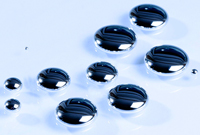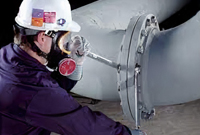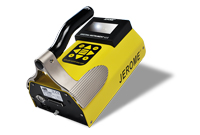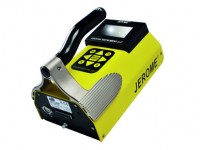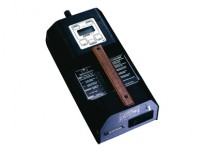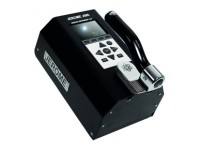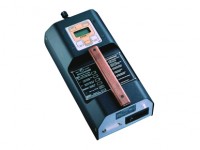Gas Analysers Measurement
When it comes to toxic gas measurement, ABLE focuses on a very niche area of analysis with emphasis on the word analyser rather than detector. The simple distinction between the two devices is that a gas detector is used to alert the user when the level of a certain gas is too high in a confined space, while a gas analyser is used to provide accurate readings of the immediate atmosphere.
ABLE specialise in the measurement of Hydrogen Sulphide (H2S) and Mercury vapour (Hg) to trace levels using the industry standard Jerome Gold Film Analysers. Hydrogen sulphide or mercury vapour adheres to the surface of the gold film causing a change in its resistance, which is converted to an H2S or Hg value. When heated, the gold film thermally releases the molecules and returns to its base resistance.
Please choose the product below that best suits your needs or call us on +44 (0) 118 9311188 for more help.
Mercury
The only metal that is a liquid at standard temperature and pressure.
The toxicity of mercury is well established, and the inhalation of the vapour can produce harmful effects on the nervous, digestive and immune systems, lungs and kidneys, and may be fatal. Therefore, these companies have a duty of care towards their employees which involves accurate monitoring of mercury levels across the plant.
Historically Mercury was known as Quicksilver and found in thermometers, manometers, barometers, dental amalgams and fluorescent light tubes. Its applications in medicine, while much less common now that the toxic effects are understood, included preservatives for vaccines, laxatives, disinfectants / antiseptics, germicidal lamps.
Mercury in the Oil & Gas Industry
ABLE has been particularly successful in selling the Jerome into offshore oil & gas applications where mercury can be found to be present in levels ranging from a few ppb to thousands of ppm. Almost all oil and gas is located within the tiny spaces in sedimentary rocks, mainly sandstone and coarse-grained limestone. Bedrock limestone and sandstone, even though hard, also contain lots of pores that can contain water, oil, gas and other elements. Along with the gas and oil is a mixture of sand, silt and mud. This sludgy silt mud is rich in heavier metal elements including Uranium and Mercury. Even the heavy Uranium can be suspended in the product as it is drawn from the well. However, because mercury exists naturally in vapour form it is readily drawn along with the gas product.
Once in the surface processing chain for oil-gas separation, mercury represents a major safety hazard, not just directly to personnel but also to the infrastructure of the asset/platform. By forming amalgams with several metals, particularly aluminium, leading to liquid metal embrittlement (LME), the result is typically failure of pipeline welds, cryogenic components, heat exchangers and hydrogenation catalysts.
Mercury will evaporate and produce harmful vapours at relatively low temperatures. When a pressurised vessel or hydrocarbon line that contains mercury droplets is depressurised, these vapours will start to be released.
When breaking containment, even though a thorough gas test has proved there is no flammable gas present, the vessel could still present a significant health risk from invisible mercury vapours.
Thus, the Jerome J405 is the instrument of choice
Electrical Waste Recycling and the WEEE* Directive
The electrical waste recycling sector is under-going something of a revolution in health & safety and automation. For companies specialising in the recycling of flat screen televisions, monitors and fluorescent lighting tubes, safety regulations under the WEEE Directive specify the need for regular mobile mercury vapour monitoring throughout the plant.
In our experience, companies typically want to implement both a mobile mercury monitoring capability for general plant safety use and a stand-alone fixed-point analyser in an enclosure to police a potential vapour “hot spot”. The go-to instrument for both applications is the proven Jerome J405 Gold Film Mercury Vapour Analyser, which is equally effective as a portable instrument or in a fixed monitoring role. For the latter, ABLE design and custom build system enclosures, applying our knowledge of delivering trace level sample concentrations with full integrity. Being able to detect mercury vapor in air at levels as low as 0.05 µg/m3 (0.0005 mg/m3), the J405’s LDL is well below the EU indicative occupational exposure limit value (IOELV) for mercury and its inorganic compounds of 0.02 mg/m3 (8-hour timeweighted average (TWA).
* Waste Electrical and Electronic Equipment recycling
Although admirably suited for occupational exposure work, the patented gold film technology at the heart of the J405 is not able to measure down to the EPA & ATSDR Clean up Levels (1 µg/m3). In order to facilitate measurements down to this concentration, Arizona Instrument added the Jerome J505, which is a portable fluorescence spectroscopy analyser, to its portfolio. With a measurement range of 0.05 to 500 µg/m3 the J505 not only exceeds the regulatory standards for industrial and residential remediation but also the action levels for OSHA, NIOSH, ACGIH and MSHA.
Hydrogen Sulphide
In industrial anaerobic digestion processes, such as waste water treatment or the digestion of organic waste from agriculture, Hydrogen Sulphide (H2S) can be formed from microbial breakdown of organic materials in the absence of oxygen. Sulphates are relatively non-inhibitory to methane forming bacteria but can be reduced to H2S by sulphate reducing bacteria, of which there are several genera.
Hydrogen sulphide is a highly toxic, colourless gas with the odour of rotten eggs, that can produce extremely rapid CNS and respiratory depression. It is also an irritant affecting skin and mucous membranes. There is no proven antidote for hydrogen sulphide poisoning. Treatment generally consists of support of respiratory and cardiovascular functions.
H2S Risks
The following statistics demonstrate the relevant toxicity of hydrogen sulphide:
- Exposure to levels of H2S from 8 ppb/0.008ppm
- 50% of humans can detect the smell of H2S at that level
- 90% at 50ppb/0.050 ppm
- Exposure to levels of > 10ppm, > 20ppm – Eye irritation
- Exposure to levels of > 50ppm, < 100ppm – Permanent eye damage can occur
- Exposure to levels of > 150ppm, < 250ppm – Olfactory nerves in the nose become paralysed – loss of sense of smell
- Exposure to levels of > 320ppm, < 530ppm – Pulmonary edema (fluid in lungs)
- Exposure to levels of > 530ppm, <1000ppm – Maximum 5-minute exposure before death results
- Exposure to levels of 1000ppm – Instant death results from a single breath
The UK Health and Safety Executive Document EH 40/2005, ‘Workplace Exposure Limits’,
in force from October 2007, sets the following workplace exposure limits for hydrogen sulphide:
| Substance | Workplace Exposure Limit | |||
| Substance Workplace Exposure Limit Long term exposure limit (8-hour TWA reference period) |
Short term exposure limit (15 min TWA reference period) |
|||
| H2S | 5 ppm | 7 Mgm3 | 10 ppm | 14 Mgm3 |
Hydrogen Sulphide in Waste-Water Treatment – Nuisance Odour Monitoring
With its low concentration measurement capability, the Jerome J605 Gold Film Hydrogen Sulphide Analyser, is ideally suited to nuisance odour monitoring such as that required on sewage treatment works (STW). Sites are often surrounded by populated areas and have many open sources of sewage water where H2S is generated as part of the natural process, such as aeration tanks and sediment beds
Whilst, with its upper limit of 10ppm, the Jerome can be high effective in safety monitoring applications, its forte, with its LDL of 3ppb and unrivalled specificity, is that of accurately measuring low levels.
The J605 has become the industry standard for STW and a highly fruitful application for the Jerome. Virtually every water company in the UK and Ireland use a Jerome, either as a portable device or in a fixed monitoring role.
Features such as On-board data logging, a USB interface for data transfer, SCADA interface via linear 4-20mA output and a light, ergonomic design are key to the Jerome’s success in this field.
One prime example of this application is Thames Water’s Mogden STW in Isleworth, which was subject to many odour-related environmental complaints from the local populace, a significant number of which resulted in legal action and prosecution. In response to this, and as part of a £140m site enhancement it was decided to upgrade the boundary monitoring network of H2S analysers.
As a result, ABLE supplied and installed 15 J605 based systems in custom built environmental enclosures to span the site’s perimeter – this development subsequently became known as the “Ring of Steel”
The LDL of the J606 easily surpasses TW’s 15ppb alarm limit and with the extensive plant coverage and fast measurement response, odour events are quickly identified and located for investigation.
In addition to its impact as a source of nuisance odour and its toxicity, H2S is corrosive, flammable, and explosive. Furthermore, it forms sulphuric acid when dissolved in water. All good reasons for closely monitoring its concentration. Consequently, the Jerome J605 has also been successfully deployed in the Energy, Geothermal, Hydro Electric, Landfill and Crude Oi/Natural Gas Markets.
Since its launch, the Jerome J605 has become the first choice for the following regulatory bodies:
Environment Agency
Scottish Environmental Protection Agency
Natural Resources Wales
Environment Protection Agency Ireland
Health & Safety Executive

